After repeated attempts to pass school privatization measures had failed, Nebraska lawmakers in 2023 approved LB 753, which creates dollar-for-dollar tax credits eventually totaling up to $100 million for donations by individuals and businesses to organizations granting private school scholarships.
 Last week, OpenSky Policy Institute kicked off its review of the key components of LB 753 with a look at the cost of the program. Future features will explore the tax credits, as well as the scholarship granting organizations (SGOs) and eligible private schools as set out in the bill. Today’s feature focuses on the scholarships and the students eligible to receive them.
Last week, OpenSky Policy Institute kicked off its review of the key components of LB 753 with a look at the cost of the program. Future features will explore the tax credits, as well as the scholarship granting organizations (SGOs) and eligible private schools as set out in the bill. Today’s feature focuses on the scholarships and the students eligible to receive them.
Current private school students likely to benefit
Beginning in 2024, taxpayers can annually divert a portion of what they owe in state taxes to SGOs, which in turn will award scholarships to students attending a private school in Nebraska. This mechanism, set out in LB 753, provides an avenue for the state to fund private schools in a way it couldn’t otherwise under the state constitution that prohibits appropriations to non-public schools.
Last year, 10% of the 365,000 pre-K through 12th grade students in Nebraska attended a private school. Based on data from similar programs in other states, the bulk of the scholarships resulting from the tax credits in Nebraska will likely go to existing private school students. In other states with programs that support private schools with taxpayers’ money – New Hampshire (89%), Arizona (80%) and Wisconsin (75%), for example – the vast majority of student applicants have never attended a public school.
In Nebraska, 9% of students live in counties where there are no private schools.
No requirement to admit students
LB 753 spells out eligibility requirements for students and priority designations that SGOs must follow in awarding scholarships. LB 753 does not guarantee a student’s admission to any private school.
For students seeking a taxpayer-funded scholarship, the eligibility requirements are broad and include anyone entering kindergarten or the ninth grade, or who attended a public school in the prior semester. Students currently enrolled in a private school are eligible if they’ve received financial assistance to cover any part of tuition or fees at any point in their schooling, including the upcoming school year.
Eligible students must reside in Nebraska.
Priorities established for granting scholarships
Each SGO will be responsible for awarding scholarships based on a priority system spelled out in LB 753. There’s nothing in the bill, however, that relates the dollar value of a scholarship to a higher or lower priority level.
Highest on the priority list are students currently receiving scholarship assistance through an SGO, along with any siblings. Second priority are students living in poverty as defined as 100% of the Federal Poverty Level (FPL) and those who were denied option enrollment to a public school, have an individualized education plan (IEP), experienced intimidation at school, are in foster care or whose parent serves in the military.
In priority tiers 3 through 5, the household income threshold steps up to 300% of what’s eligible to qualify for reduced-price school lunches ($166,500 for a family of four). In Nebraska, 80% of households have incomes below $138,000.
SGOs determine scholarship amounts
There’s nothing in LB 753 that specifically spells out scholarship amounts. A scholarship, according to the bill, can cover all or part of tuition and fees for attending a private school with the only limitation being that the amount can’t exceed the “cost of educating an eligible student” as determined by each school.
In Iowa, and in other states where school privatization measures have expanded, some private schools have responded with significant hikes in tuition. A majority of Nebraska voters (58%) surveyed this spring said it was “bad” or “very bad” that private schools benefiting from the taxpayer-funded scholarships aren’t held to the same accountability standards as public schools when it comes to how the money is spent.
For each SGO, the average amount of the scholarships that it awards each year is capped at 75% of what the state spends to educate a public school student, which this year is about $9,200. There’s no minimum set for an average scholarship, although each SGO is required to award a minimum percentage of its revenue each year.
After three years, the Department of Education is to document the number of students left on a waiting list or denied a scholarship along with demographic information on the students awarded scholarships.
Signature-gathering effort continues
Support Our Schools Nebraska, a coalition of public school supporters, is gathering signatures in a referendum petition campaign to put LB 753 before voters in November 2024.
More on LB 753 to come at openskypolicy.org.
